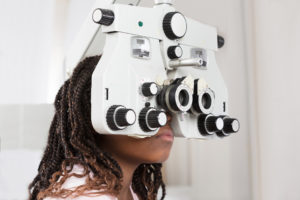October 3, 2022
By Hashim Ali Khan, OD, FAAO, PhD candidate at Brien Holden Vision Institute

Cycloplegic refraction is the gold standard method for epidemiological studies in children and adolescents, but the use of cycloplegia in young adults is still controversial. A large body of evidence indicates that non-cycloplegia results in more positive or less negative than non-cycloplegic refractions.
One percent cyclopentolate is commonly considered for cycloplegia, given a rapid onset of cycloplegia and a faster recovery time compared to atropine. Although faster than atropine, recovery time from the use of cyclopentolate is still an issue. In comparison, tropicamide has a much shorter recovery time but is considered a weak cycloplegic. There is a need for a cycloplegic agent with a quick onset of action and short recovery time that provides accurate refractions.
In this double-masked randomized clinical trial, 300 Chinese young adult myopes (aged 17 to 22) were randomly assigned in equal proportions to cyclopentolate or tropicamide groups. After baseline ocular assessment, including non-cycloplegic autorefraction, cycloplegia was induced with either cyclopentolate or tropicamide. Subjects in the cyclopentolate group received two drops of cyclopentolate hydrochloride 1% (Alcon) five minutes apart and underwent cycloplegic autorefraction and subjective refraction 30-45 minutes after the installation of the last drop. In the tropicamide group, four drops of Mydrin P (Tropicamide 0.5%, phenylephrine HCl 0.5%; Santen Pharmaceutical, Shiga, Japan), five minutes apart, were instilled, and cycloplegic autorefraction and subjective refraction were performed 20 to 30 minutes after the last drop. The values of spherical equivalent (SE), sphere component, and cylinder component before and after cycloplegia were compared as well as the correlation between the cycloplegic autorefraction and cycloplegic subjective refraction.
The results indicate that even in young adults there are significant differences in SE and spherical component between non-cycloplegic and cycloplegic autorefraction (difference of approximately 0.40D with the most significant difference in hyperopes and least in high myopes); however, the cylindrical component of the refraction was not affected. More positive (or less negative) refractions were associated with cycloplegia. Additionally, the results for change in SE and sphere were comparable between cyclopentolate and tropicamide. These findings indicate the need for cycloplegia in young adults and suggest that tropicamide can achieve a cycloplegic effect comparable to cyclopentolate in young-adult myopes with dark irides.
ABSTRACT
A Randomized Clinical Trial Using Cyclopentolate and Tropicamide to Compare Cycloplegic Refraction in Chinese Young Adults with Dark Irises
Ruxia Pei, Zhuzhu Liu, Hua Rong, Liqiong Zhao, Bei Du, Na Jin, Hongmei Zhang, Biying Wang, Yi Pang & Ruihua Wei
Background: To evaluate the necessity of cycloplegia for epidemiological studies of refraction in Chinese young adults (aged 17–22 years) with dark irises, and to compare the cycloplegic effects of 1% cyclopentolate and 0.5% tropicamide in them.
Methods: A total of 300 young adults (108 males and 192 females) aged 17 to 22 years (mean 19.03 ± 1.01) were recruited from Tianjin Medical University from November 2019 to January 2020. Participants were randomly divided into two groups. In the cyclopentolate group, two drops of 1% cyclopentolate eye drop were administrated (one drop every 5 min), followed by autorefraction and subjective refraction 30 to 45 min later. In the tropicamide group, four drops of 1% Mydrin P (Tropicamide 0.5%, phenylephrine HCl 0.5%) were given (one drop every 5 min), followed by autorefraction and subjective refraction 20 to 30 min later. The participants and the examiners were masked to the medication. Distance visual acuity, intraocular pressure (IOP), non-cycloplegic and cycloplegic autorefraction (Topcon KR-800, Topcon Co. Tokyo, Japan), non-cycloplegic and cycloplegic subjective refraction and ocular biometry (Lenstar LS-900) were performed.
Results: The values of spherical equivalent (SE) and sphere component were significantly different before and after cycloplegia in the cyclopentolate group and the tropicamide group (p < 0.05). The mean difference between noncycloplegic and cycloplegic autorefraction SE was 0.39 D (±0.66 D) in the cyclopentolate group and 0.39 D (±0.34 D) in the tropicamide group. There was no significant difference in the change of SE and sphere component after cycloplegia between the cyclopentolate group and the tropicamide group (p > 0.05). In each group, no significant difference was found between autorefraction and subjective refraction after cycloplegia (p > 0.05). We also found that more positive or less negative cycloplegic refraction was associated with the higher difference in SE in each group.
Conclusions: Cycloplegic refractions were generally more positive or less negative than non-cycloplegic refractions. It is necessary to perform cycloplegia for Chinese young adults with dark irises to obtain accurate refractive errors. We suggest that cycloplegic autorefraction using tropicamide may be considered as a reliable method for epidemiological studies of refraction in Chinese young adults with dark irises.
Pei, R., Liu, Z., Rong, H., Zhao, L., Du, B., Jin, N., … & Wei, R. (2021). A randomized clinical trial using cyclopentolate and tropicamide to compare cycloplegic refraction in Chinese young adults with dark irises. BMC ophthalmology, 21(1), 1-9.
DOI: 10.1186/s12886-021-02001-6
 |
Hashim Ali Khan, OD, FAAO, is a current PhD student working on predictive models for myopia progression with Professor Padmaja Sankaridurg at the Brien Holden Vision Institute, University of New South Wales, Sydney. |













